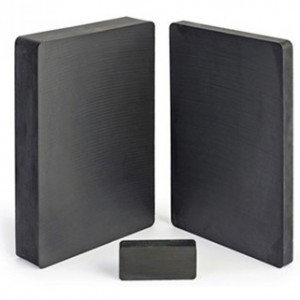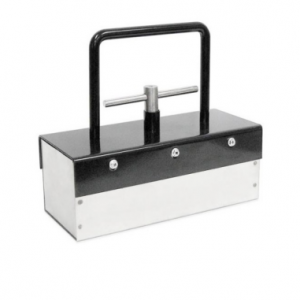China New Product China Ferrite Made by Ceramic Process
Our growth depends over the superior equipment ,outstanding talents and continuously strengthened technology forces for China New Product China Ferrite Made by Ceramic Process, Your help is our everlasting electricity! Warmly welcome customers at your home and abroad to go to our enterprise.
Our growth depends over the superior equipment ,outstanding talents and continuously strengthened technology forces forChina Strong Permanent Magnet,Ferrite Segment, Wide selection and fast delivery to suit your needs! Our philosophy: Good quality, great service, keep improving. We are looking forward that more and more oversea friends join in our family for further development near the future!
Introduction:
Hard ferrites based on barium ferrite and strontium powders (chemical formula BaO • 6Fe2O3 and SrO • 6Fe2O3) manufactured. They consist of oxidized metals, thus included in the ceramic materials group. They consist of approx. 90% iron oxide (Fe2O3) and 10% alkaline earth oxide (BaO or SrO) – raw materials which are plentiful and inexpensive. They divide into isotropic and anisotropic, the particles of the latter are aligned in a single
direction which obtaining better magnetic characteristics. Isotropic magnets are shaped by compressing while anisotropic magnets are compressed within a magnetic field. This provides the magnet with a preferential direction and triples its energy density.
Advantage:
As is typical of oxide ceramics, hard ferrite magnets display relatively resistant behavior towards moisture, solvents, alkaline solutions, weak acids, salts, lubricants and gas pollutants. Generally, hard ferrite magnets can therefore be used without additional corrosion protection.
Feature:
Due to their great hardness (6-7 Mohs), Ferrite magnets are brittle and sensitive to knocks or bending. During processing, they have to be machined with diamond tools. Operating temperatures with ferrite magnets are generally between –40ºC and 250ºC.
Application:
Different shapes are used in utomotive engineering, such as automation and measurement control. Other applications such as Automobile electrical machinery (wipers, sit chair motor), Teaching, Door absorber, Magnetic bike and massage chair, etc.
Today, hard ferrites represent the largest proportion of permanent magnets produced. In contrast to AlNiCo magnets, hard ferrites are characterized by flux densities but high coercive field strengths. This results in the generally flat shape of the materials. Barium ferrite and strontium ferrite are differentiated depending on the starting material. All stated values were determined using standard samples according IEC 60404-5. The following specifications serve as reference values and may differ.
| Sintered Ferrite Magnet Physical Properties | ||||||||
| Grade | Remanence | Rev. Temp. Coeff. Of Br | Coercive Force | Intrinsic Coercive Force | Rev. Temp.-Coeff. Of Hcj | Max. Energy Product | Max. Operating Temperature | Density |
| Br (KGs) | Hcb (YOU) | Hcj (YOU) | (BH)max. (MGOe) | g/cm³ | ||||
| Y10T | 2.0-2.35 | -0.20 | 1.57-2.01 | 2.64-3.52 | +0.30 | 0.8-1.2 | 250℃ | 4.95 |
| Y20 | 3.2-3.8 | -0.20 | 1.70-2.38 | 1.76-2.45 | +0.30 | 2.3-2.8 | 250℃ | 4.95 |
| Y22H | 3.1-3.6 | -0.20 | 2.77-3.14 | 3.52-4.02 | +0.30 | 2.5-3.2 | 250℃ | 4.95 |
| Y23 | 3.2-3.7 | -0.20 | 2.14-2.38 | 2.39-2.89 | +0.30 | 2.5-3.2 | 250℃ | 4.95 |
| Y25 | 3.6-4.0 | -0.20 | 1.70-2.14 | 1.76-2.51 | +0.30 | 2.8-3.5 | 250℃ | 4.95 |
| Y26H | 3.6-3.9 | -0.20 | 2.77-3.14 | 2.83-3.21 | +0.30 | 2.9-3.5 | 250℃ | 4.95 |
| Y27H | 3.7-4.0 | -0.20 | 2.58-3.14 | 2.64-3.21 | +0.30 | 3.1-3.7 | 250℃ | 4.95 |
| Y28 | 3.7-4.0 | -0.20 | 2.20-2.64 | 2.26-2.77 | +0.30 | 3.3-3.8 | 250℃ | 4.95 |
| Y30 | 3.7-4.0 | -0.20 | 2.20-2.64 | 2.64-2.77 | +0.30 | 3.3-3.8 | 250℃ | 4.95 |
| Y30H-1 | 3.8-4.0 | -0.20 | 2.89-3.46 | 2.95-3.65 | +0.30 | 3.4-4.1 | 250℃ | 4.95 |
| Y30BH | 3.8-3.9 | -0.20 | 2.80-2.95 | 2.90-3.08 | +0.30 | 3.4-3.7 | 250℃ | 4.95 |
| Y30-1 | 3.6-4.0 | -0.20 | 1.70-2.14 | 1.76-2.51 | +0.30 | 2.8-3.5 | 250℃ | 4.95 |
| Y30BH-1 | 3.8-4.0 | -0.20 | 2.89-3.46 | 2.95-3.65 | +0.30 | 3.4-4.0 | 250℃ | 4.95 |
| Y30H-2 | 3.95-4.15 | -0.20 | 3.46-3.77 | 3.90-4.21 | +0.30 | 3.5-4.0 | 250℃ | 4.95 |
| Y20-2 | 3.95-4.15 | -0.20 | 3.46-3.77 | 3.90-4.21 | +0.30 | 3.5-4.0 | 250℃ | 4.95 |
| Y32 | 4.0-4.2 | -0.20 | 2.01-2.38 | 2.07-2.45 | +0.30 | 3.8-4.2 | 250℃ | 4.95 |
| Y33 | 4.1-4.3 | -0.20 | 2.77-3.14 | 2.83-3.21 | +0.30 | 4.0-4.4 | 250℃ | 4.95 |
| Y35 | 4.0-4.1 | -0.20 | 2.20-2.45 | 2.26-2.51 | +0.30 | 3.8-4.0 | 250℃ | 4.95 |
| Note: | ||||||||





